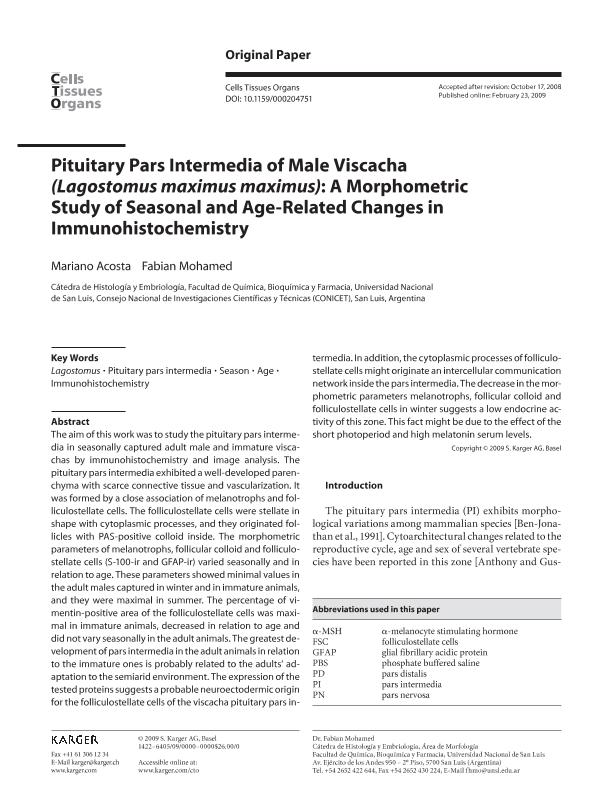Mostrar el registro sencillo del ítem
dc.contributor.author
Acosta, Mariano

dc.contributor.author
Mohamed, Fabian Heber

dc.date.available
2019-12-30T15:42:01Z
dc.date.issued
2009-09
dc.identifier.citation
Acosta, Mariano; Mohamed, Fabian Heber; Pituitary pars intermedia of male viscacha (lagostomus maximus maximus): A morphometric study of seasonal and age-related changes in immunohistochemistry; Karger; Cells Tissues Organs; 190; 4; 9-2009; 219-229
dc.identifier.issn
1422-6405
dc.identifier.uri
http://hdl.handle.net/11336/93232
dc.description.abstract
The aim of this work was to study the pituitary pars intermedia in seasonally captured adult male and immature viscachas by immunohistochemistry and image analysis. The pituitary pars intermedia exhibited a well-developed parenchyma with scarce connective tissue and vascularization. It was formed by a close association of melanotrophs and folliculostellate cells. The folliculostellate cells were stellate in shape with cytoplasmic processes, and they originated follicles with PAS-positive colloid inside. The morphometric parameters of melanotrophs, follicular colloid and folliculostellate cells (S-100-ir and GFAP-ir) varied seasonally and in relation to age. These parameters showed minimal values in the adult males captured in winter and in immature animals, and they were maximal in summer. The percentage of vimentin-positive area of the folliculostellate cells was maximal in immature animals, decreased in relation to age and did not vary seasonally in the adult animals. The greatest development of pars intermedia in the adult animals in relation to the immature ones is probably related to the adults' adaptation to the semiarid environment. The expression of the tested proteins suggests a probable neuroectodermic origin for the folliculostellate cells of the viscacha pituitary pars intermedia. In addition, the cytoplasmic processes of folliculostellate cells might originate an intercellular communication network inside the pars intermedia. The decrease in the morphometric parameters melanotrophs, follicular colloid and folliculostellate cells in winter suggests a low endocrine activity of this zone. This fact might be due to the effect of the short photoperiod and high melatonin serum levels.
dc.format
application/pdf
dc.language.iso
eng
dc.publisher
Karger

dc.rights
info:eu-repo/semantics/openAccess
dc.rights.uri
https://creativecommons.org/licenses/by-nc-sa/2.5/ar/
dc.subject
AGE
dc.subject
IMMUNOHISTOCHEMISTRY
dc.subject
LAGOSTOMUS
dc.subject
PITUITARY PARS INTERMEDIA
dc.subject
SEASON
dc.subject.classification
Bioquímica y Biología Molecular

dc.subject.classification
Ciencias Biológicas

dc.subject.classification
CIENCIAS NATURALES Y EXACTAS

dc.title
Pituitary pars intermedia of male viscacha (lagostomus maximus maximus): A morphometric study of seasonal and age-related changes in immunohistochemistry
dc.type
info:eu-repo/semantics/article
dc.type
info:ar-repo/semantics/artículo
dc.type
info:eu-repo/semantics/publishedVersion
dc.date.updated
2019-11-25T18:21:46Z
dc.journal.volume
190
dc.journal.number
4
dc.journal.pagination
219-229
dc.journal.pais
Suiza

dc.journal.ciudad
Basilea
dc.description.fil
Fil: Acosta, Mariano. Consejo Nacional de Investigaciones Científicas y Técnicas. Centro Científico Tecnológico Conicet - San Luis. Instituto de Química de San Luis. Universidad Nacional de San Luis. Facultad de Química, Bioquímica y Farmacia. Instituto de Química de San Luis; Argentina
dc.description.fil
Fil: Mohamed, Fabian Heber. Universidad Nacional de San Luis. Facultad de Química, Bioquímica y Farmacia; Argentina
dc.journal.title
Cells Tissues Organs

dc.relation.alternativeid
info:eu-repo/semantics/altIdentifier/url/https://www.karger.com/Article/Abstract/204751
dc.relation.alternativeid
info:eu-repo/semantics/altIdentifier/doi/http://dx.doi.org/10.1159/000204751
Archivos asociados
